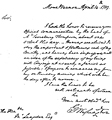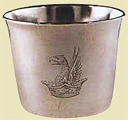 |

9. Inkwell
|
 |


9. INKWELL
Symbolic:
 |
 |

Copy of Washington’s letter to Congress accepting the presidency, dated April 14, 1789
Chicago Historical Society
|
The inkwell and quill may refer to the making of laws and the fact that Washington wrote and signed many important documents in his lifetime. The two documents on the table could be Stuart’s way of symbolizing Washington’s role in important documents, but Stuart does not portray any specific document, such as the recently signed Jay’s Treaty.
 |
 |

Lafayette’s departure from Mount Vernon 1784, showing Washington with his family and dogs
Library of Congress
|
Dogs standing guard at the corners of the inkwell would remind classically educated viewers of Plutarch's observation: They symbolize “the conservative watchful, philosophical principle of life.” Washington would certainly have endorsed those sentiments.
 |
 |

Silver camp cup engraved with George Washington’s crest, 1776
National Museum of American History, Smithsonian Institution, Behring Center
|
The inkwell displays the Washington family coat of arms, the crest of which George Washington changed from a raven to a griffin (a mythological creature with the body of a lion and the head of a hawk).
Biographic:
 |
 |

Autograph letter to Henry Knox, April 1, 1789
The Gilder Lehrman Collection, on deposit at
The Pierpont Morgan Library, GLC 185
|
Washington composed thousands of letters, but a secretary handled much of his correspondence. The mail service was unreliable, so they often sent several copies by different routes. Because a letter writer did not know whether a letter reached a recipient, a response was important, for it confirmed delivery. Transatlantic mail was notoriously slow, normally taking six weeks to three months to arrive. In a January 30, 1785, letter to British radical Patience Wright, Washington apologizes for not having responded to her letter, dated December 8, 1783, because it had just arrived.
 |
 |

Letter from George to Martha Washington
The Mount Vernon
Ladies’ Association
|
We have no idea how many documents Washington himself wrote. Mrs. Washington reportedly burned all the correspondence she and her husband had exchanged, although she may have overlooked a few letters. Early biographers and editors handled his correspondence carelessly, which may have led to other losses.
 |
 |

Copy of Declaration of Independence, 1776
Library of Congress
|
In July 1776, Washington was in New York, commanding the Continental Army, when the writers and signers of the Declaration of Independence met in Philadelphia. But he was in that city on September 17, 1789, when he signed the proposed U.S. Constitution as presiding officer and a deputy from Virginia.
 |
 |

Census of slaves at Mount Vernon, listed by George Washington, July, 1799
The Mount Vernon
Ladies’ Association
|
When he left office, Washington returned, with great delight, to his beloved Mount Vernon. He drew up a new will that freed his slaves, numbering about 300, upon Martha’s death. He enjoyed less than three years of retirement. On December 14, 1799, he died at home of a throat infection. His last words were “Tis well.” Newspapers bordered in black told the nation of Washington’s death.
Artistic:
 |
 |

Portable writing case
used by George Washington during
the Revolutionary War
National Museum of American History, Smithsonian Institution, Behring Center
|
Although Washington owned a great quantity of silver, which he took care to order with his full arms or the crest, the inkwell in the painting may not be a real object. Stuart generally did not use what we would call props. The inkwell, fashioned in the neoclassical boat design inspired by Roman antiquity, apparently came from his imagination. A quill pen rests in a hole in the roof of the inkwell’s “cabin.“ Also on the table is Washington’s black hat, of which there were contemporary descriptions.
|




